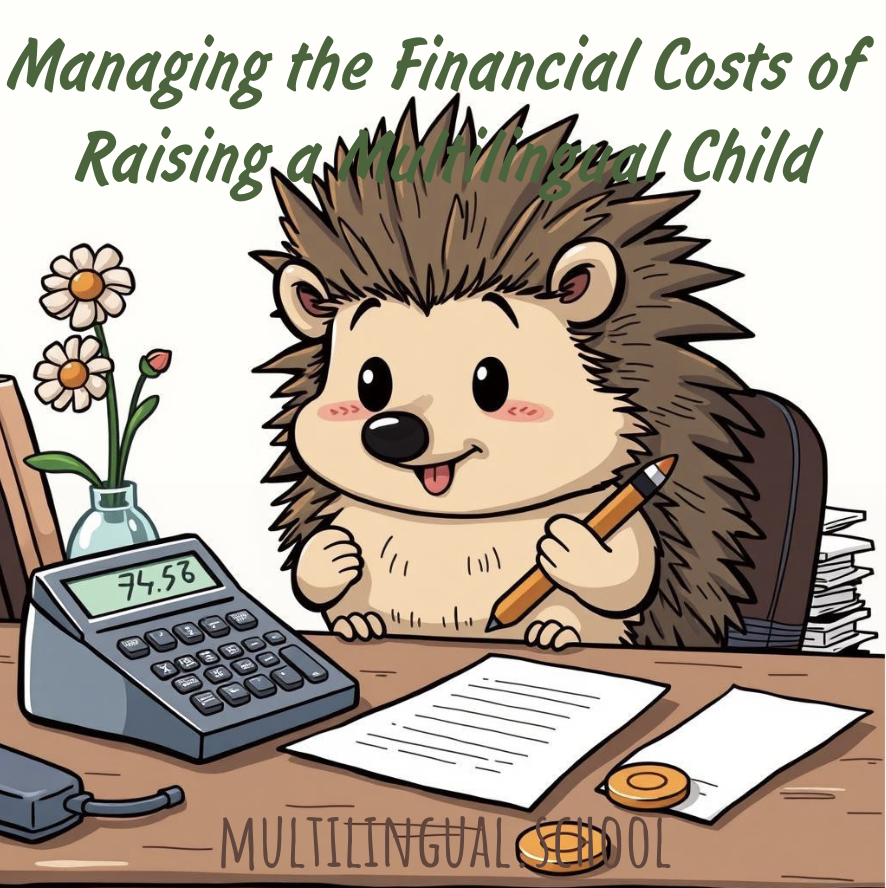Understanding Pronunciation Development in Multilingual Kids
This post may contain affiliate links, which means that I may receive a commission if you make a purchase using these links. You do not pay a higher price.
Pronunciation Development in Multilingual Kids: Looking at German, English and Portuguese in particular
Raising children with multiple languages abroad is an enriching yet complex journey, especially when it comes to pronunciation development. Multilingual children—those exposed to two or more languages from birth or early childhood—face unique opportunities and challenges in mastering the sounds of each language. This blog post explores the research behind pronunciation development in multilingual kids, with a focus on English, German, and Portuguese, offering insights and practical considerations for parents navigating this path abroad.
The Basics of Pronunciation Development
Pronunciation development, or phonological development, refers to how children learn to perceive, produce, and distinguish the sounds (phonemes) of a language. For multilingual children, this process involves juggling multiple sound systems simultaneously, which can influence the pace and patterns of their pronunciation development compared to monolingual peers. Research highlights several key stages and factors:
Critical Period for Sound Acquisition
From birth to around age 3, children are in a critical period of brain plasticity, making them exceptionally adept at detecting and internalizing linguistic patterns. During this phase, their brains are wired to distinguish phonemes—the smallest units of sound in a language—across all their languages. For example, by 6–12 months, multilingual infants exposed to English, German, and Portuguese will start distinguishing English /b/ vs. /p/ (as in "bat" vs. "pat"), German /ʃ/ vs. /s/ (as in "Schule" vs. "See"), and Portuguese nasal vowels like /ã/ vs. /a/ (as in "mãe" vs. "pai"). However, without consistent exposure, they may lose the ability to perceive sounds not present in their dominant language(s).Phonological Milestones
By age 3, most children, whether monolingual or multilingual, acquire the majority of consonants in their language(s), with full mastery of complex sounds and prosody (rhythm, stress, intonation) continuing to develop through age 5–7. For multilingual children, milestones may vary slightly depending on exposure and language similarity. For instance:English: Most consonants (e.g., /p/, /b/, /m/, /n/, /t/, /d/) are acquired by age 3, but sounds like /θ/ (as in "think") and /ð/ (as in "this") may take until age 5–6 due to their rarity across languages.
German: Children typically master front rounded vowels (e.g., /y/ in "Hütte") and fricatives like /ç/ (as in "ich") by age 4–5, though these can be challenging for non-native speakers due to their absence in many other languages.
Portuguese: Nasal vowels (e.g., /ẽ/ in "bem") and the uvular /ʁ/ (as in "carro") are often mastered by age 4, but these sounds are unique to Portuguese and can be tricky for children dominant in English or German.
Cross-Linguistic Influence
Multilingual children’s pronunciation development is shaped by cross-linguistic influence, where the sound systems of their languages interact. This can lead to transfer (using features of one language in another) or interference (errors due to overlap). For example:A child dominant in English might struggle with German’s front rounded vowels, substituting /u/ for /y/, pronouncing "Hütte" (hut) as "Hutte."
A child strong in Portuguese might nasalize vowels in English or German, saying "man" as [mæ̃] or "Mann" as [mã].
Conversely, a child dominant in German might struggle with Portuguese’s nasal vowels, flattening "mãe" (mother) to sound more like "mai."
Factors Influencing Pronunciation Development
Research identifies several factors that shape how multilingual children develop pronunciation across languages like English, German, and Portuguese, especially when raised abroad:
Amount and Quality of Exposure
Studies emphasize that the proportion of time spent in each language is a major predictor of pronunciation proficiency. For a child to achieve native-like pronunciation, they need at least 20–25% of their waking hours (roughly 2.5–3.5 hours daily) in each language, consistently from infancy. Abroad, where one language (e.g., English in an English-speaking country) may dominate community and school contexts, parents must ensure robust exposure to German and Portuguese. Interactive input—live, face-to-face communication from native speakers—is crucial, as passive exposure (e.g., TV, background chatter) is far less effective. For example, a child in the US might get ample English input at school but needs deliberate German storytime with a parent or Portuguese playdates to maintain those sound systems.Language Similarity and Phonological Distance
The structural similarity between languages influences pronunciation development. English, German, and Portuguese, while all Indo-European, have distinct phonological systems:English and German: These languages share some sounds (e.g., /p/, /t/, /k/) but differ in others. German has front rounded vowels (/y/, /ø/) and the uvular /ʁ/, absent in English, while English has interdental fricatives (/θ/, /ð/), absent in German. Multilingual children may transfer English’s alveolar /r/ to German, pronouncing "rot" (red) with a rhotic /ɹ/ instead of the uvular /ʁ/.
Portuguese: Portuguese’s nasal vowels and diphthongs (e.g., /ãw/ in "pão") are unique compared to English and German, making them challenging for children dominant in those languages. Conversely, Portuguese’s /ʃ/ (as in "chá") is similar to German’s /ʃ/ (as in "Schule"), potentially easing transfer between these two.
Research using tools like the Levenshtein algorithm, which measures pronunciation distance between dialects or languages, shows that greater phonological distance (e.g., English vs. Portuguese) can increase the difficulty of mastering pronunciation in the less-exposed language. Abroad, where exposure to Portuguese might be limited, children may struggle more with its unique sounds compared to German, which shares more phonetic features with English.
Age of Exposure
The age at which a child is exposed to each language affects pronunciation outcomes. Simultaneous multilinguals (exposed to all languages from birth) are more likely to achieve native-like pronunciation in English, German, and Portuguese, provided exposure is balanced. Sequential multilinguals (exposed to additional languages after age 3) may retain slight accents in later-acquired languages, especially if exposure is inconsistent. For example, a child born in Germany, speaking German and Portuguese at home, who moves to the UK at age 5 and starts learning English, might develop a slight German or Portuguese accent in English, particularly with sounds absent in their earlier languages (e.g., /θ/, /ð/).Social and Educational Context
Abroad, the dominant community language often influences pronunciation development, especially if it’s the language of schooling. For instance, a child in the US attending an English-medium school might excel in English pronunciation but struggle with German fricatives or Portuguese nasal vowels without targeted support. Research also notes that social preferences can shape pronunciation—children may prioritize sounding “native” in the community language (e.g., English) to fit in, potentially neglecting German or Portuguese sounds. In contrast, in multilingual hubs like Luxembourg, where schools may support multiple languages, pronunciation development can be more balanced, though heritage languages like Portuguese often receive less institutional support.
Challenges in Pronunciation Development
Multilingual children abroad face specific challenges in pronunciation development, particularly when balancing English, German, and Portuguese:
Interference and Code-Switching
Interference occurs when a child applies the pronunciation rules of one language to another, leading to errors. For example, a child might use English’s lax vowels in German, pronouncing "See" (lake) as [si] instead of [ze:], or apply Portuguese’s nasalization to English, saying "pen" as [pẽ]. Code-switching—mixing languages within utterances—is common and developmentally normal, but it can temporarily affect pronunciation clarity. For instance, a child might say "Ich gehe to the park" (German-English mix), potentially carrying over English vowel sounds into German.Uneven Exposure
Abroad, exposure to minority languages like German and Portuguese is often limited compared to the dominant language (e.g., English). Research shows that if exposure to a language drops below 20% of waking hours, pronunciation proficiency can suffer, leading to receptive skills (understanding) outpacing productive skills (speaking). For example, a child in Canada might understand German or Portuguese but struggle to produce the uvular /ʁ/ or nasal vowels accurately due to limited practice opportunities.Accent Perception and Social Pressure
Studies on accent perception highlight that multilingual children abroad may face social pressure to conform to the dominant language’s pronunciation norms. For instance, in an English-speaking country, a child might prioritize mastering English’s /θ/ and /ð/ to avoid standing out, potentially at the expense of maintaining German’s /ç/ or Portuguese’s /ʃ/. This social dynamic can lead to a phenomenon known as “language dominance,” where pronunciation in the community language becomes more native-like, while minority languages may retain a slight accent.
Strategies to Support Pronunciation Development
Parents raising multilingual children abroad can use research-backed strategies to foster balanced pronunciation development across English, German, and Portuguese:
Ensure Consistent, Interactive Exposure
Aim for 3–5 hours of interactive exposure daily per language, totaling 4,000–6,000 hours by age 3–5 for native-like pronunciation. Abroad, this might mean:English: Leverage school and community interactions, supplemented by reading aloud English books to reinforce sounds like /θ/ and /ð/.
German: Use the “one parent, one language” (OPOL) approach, where one parent speaks only German, focusing on challenging sounds like /y/, /ø/, and /ç/ through songs, rhymes, and games (e.g., clapping syllables in "Apfelbaum").
Portuguese: Arrange playdates with Portuguese-speaking families or use online resources (e.g., Brazilian storytime videos) to practice nasal vowels and diphthongs, such as singing "Aquarela" to highlight /ã/ and /ẽ/.
Separate Languages by Context
To minimize interference, assign distinct contexts to each language. For example, use English at school, German with one parent, and Portuguese during cultural activities or with extended family via video calls. This separation helps children mentally compartmentalize sound systems, reducing errors like pronouncing German "rot" with an English /ɹ/ or Portuguese "mãe" without nasalization.Target Specific Sounds
Focus on language-specific sounds that are prone to transfer or interference:English: Practice interdental fricatives (/θ/, /ð/) with minimal pairs (e.g., "think" vs. "sink") and tongue twisters (e.g., "Three thoughtful thinkers").
German: Emphasize front rounded vowels (/y/, /ø/) with games like rhyming "Hütte" with "Mütze," and practice the uvular /ʁ/ by gargling sounds during play.
Portuguese: Reinforce nasal vowels with songs or stories emphasizing words like "mão" and "bem," and practice the uvular /ʁ/ (similar to German) by contrasting "carro" (car) with "caro" (expensive).
Leverage Community Resources
Abroad, seek out community resources to boost exposure to minority languages. For example, in the US, German schools abroad or Portuguese cultural associations can provide structured pronunciation practice. Online platforms, such as Goethe-Institut for German or Instituto Camões for Portuguese, offer resources tailored to children, including pronunciation exercises and interactive stories.Monitor and Celebrate Progress
Track pronunciation milestones to ensure balanced development, but remember that temporary mixing or errors are normal. Celebrate successes, such as a child correctly pronouncing German’s "ich" (/ɪç/) or Portuguese’s "pão" (/pãw/), to boost motivation. If progress in a language lags significantly (e.g., inability to produce Portuguese nasal vowels by age 5), consider increasing exposure or consulting a speech-language pathologist familiar with multilingual development to rule out underlying issues.
Critical Considerations for Multilingual Pronunciation Abroad
While the establishment narrative often emphasizes the benefits of multilingualism—such as enhanced cognitive flexibility and cultural awareness—it’s important to critically examine potential oversights. Research on multilingual pronunciation development abroad often focuses on idealized scenarios, assuming balanced exposure and access to resources, which may not reflect the realities of many families. For instance, in countries with monolingual education systems (e.g., the US, UK), institutional support for languages like German and Portuguese is often limited, placing a heavy burden on parents to maintain pronunciation proficiency. This can exacerbate inequalities, as families with fewer resources (e.g., time, money, community networks) may struggle to provide adequate exposure, potentially leading to incomplete pronunciation mastery in minority languages.
Moreover, the narrative of “native-like” pronunciation as the gold standard can be problematic. While achievable with early, consistent exposure, it’s not always necessary for functional communication, and the pressure to achieve it may cause stress for both children and parents. Research also highlights that pronunciation development is not linear—multilingual children may temporarily lag in one language but catch up later, especially with increased exposure. For example, a child in Australia might initially struggle with German’s uvular /ʁ/ due to English dominance but master it by age 6 with targeted practice during visits to Germany.
Final Takeaway
Understanding pronunciation development in multilingual kids abroad requires recognizing the interplay of exposure, language similarity, and social context. For children learning English, German, and Portuguese, parents can foster balanced pronunciation by ensuring consistent, interactive exposure, targeting language-specific sounds, and leveraging community resources. While challenges like interference and uneven exposure are common, they are not insurmountable, and temporary lags are part of the multilingual journey. Critically, the goal should not be perfection but functional proficiency, enabling children to communicate confidently across their linguistic worlds, embracing the diversity and richness of their multilingual identity.













